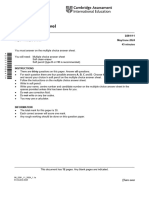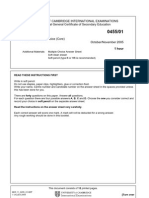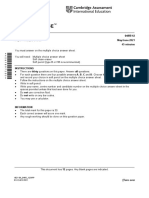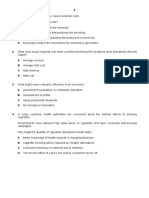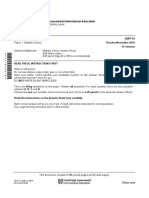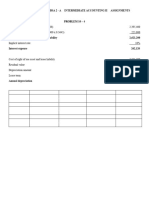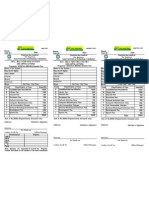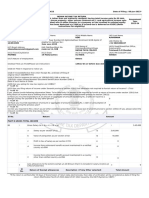Economics: University of Cambridge International Examinations General Certificate of Education Advanced Level
Economics: University of Cambridge International Examinations General Certificate of Education Advanced Level
Uploaded by
Munashe ChitawaCopyright:
Available Formats
Economics: University of Cambridge International Examinations General Certificate of Education Advanced Level
Economics: University of Cambridge International Examinations General Certificate of Education Advanced Level
Uploaded by
Munashe ChitawaOriginal Title
Copyright
Available Formats
Share this document
Did you find this document useful?
Is this content inappropriate?
Copyright:
Available Formats
Economics: University of Cambridge International Examinations General Certificate of Education Advanced Level
Economics: University of Cambridge International Examinations General Certificate of Education Advanced Level
Uploaded by
Munashe ChitawaCopyright:
Available Formats
UNIVERSITY OF CAMBRIDGE INTERNATIONAL EXAMINATIONS
General Certificate of Education Advanced Level
ECONOMICS 9708/03
Paper 3 Multiple Choice (Extension)
May/June 2005
1 hour
Additional Materials: Multiple Choice Answer Sheet
Soft clean eraser
Soft pencil (type B or HB is recommended)
READ THESE INSTRUCTIONS FIRST
Write in soft pencil.
Do not use staples, paper clips, highlighters, glue or correction fluid.
Write your name, Centre number and candidate number on the answer sheet in the spaces provided unless
this has been done for you.
There are thirty questions on this paper. Answer all questions.
For each question there are four possible answers A, B, C and D. Choose the one you consider correct and
record your choice in soft pencil on the separate answer sheet.
Read the instructions on the answer sheet very carefully.
Each correct answer will score one mark. A mark will not be deducted for a wrong answer.
Any rough working should be done in this booklet.
This document consists of 12 printed pages.
IB05 06_9708_03/RP
UCLES 2005 [Turn over
2
1 Which condition defines productive efficiency?
A All factors of production are fully employed.
B All firms are producing at their profit-maximising levels of output.
C The output of all goods is produced at minimum cost.
D There are no further opportunities for substituting capital for labour.
2 The relative prices of goods reflect their marginal utilities rather than their total utilities.
What is explained by this statement?
A the law of diminishing returns
B the limitations of marginal utility theory
C the paradox of value
D the role of prices as a rationing mechanism
3 In the diagram a consumer's budget line shifts from GH to JK.
G
good Y
O H K
good X
Regardless of any other changes that might occur, what must be correct?
A There has been an increase in the consumer's money income.
B There has been an increase in the consumer's real income.
C There has been an equal proportionate increase in the price of X and Y.
D There has been an equal proportionate decrease in the price of X and Y.
© UCLES 2005 9708/03/M/J/05
3
4 According to the law of diminishing returns, what happens as more of a variable factor is
combined with a fixed factor?
A An increase in the price of the variable factor will eventually result in an increase in
production costs.
B A reduction in the quality of the variable factor will eventually result in an increase in
production costs.
C Fewer units of the variable factor will be needed to produce equal increases in output.
D The proportions in which the factors are combined will eventually result in progressively
smaller increases in output.
5 When would a trade union be most likely to secure a wage rise for its members?
A when labour costs are a small proportion of total costs
B when the demand for the product is price-elastic
C when there are a large number of small producers
D when the supply of labour is elastic
6 In the diagram S1 is an individual worker's initial supply of labour curve.
S2
S1
wage
rate
O hours of work
What could cause the curve to shift to S2?
A an increase in the hourly wage rate
B an increased preference for leisure
C an increase in the opportunity cost of leisure
D an increase in work satisfaction
© UCLES 2005 9708/03/M/J/05 [Turn over
4
7 Wages in industry X are significantly higher than in industry Y.
What could explain this difference?
A Workers in industry Y are highly mobile.
B Trade union organisation in industry Y is relatively strong.
C Industries X and Y compete with each other for workers.
D There are non-pecuniary advantages to working in industry Y.
8 What is generally thought to be the main reason why firms might experience decreasing returns
to scale when they grow beyond a certain size?
A financial diseconomies
B managerial diseconomies
C marketing diseconomies
D technical diseconomies
9 In the diagram, XY is a firm’s total cost curve.
total
costs
X
O output
What happens to the firm’s costs as output is increased?
average fixed costs marginal costs
A decrease constant
B decrease increase
C constant constant
D constant increase
© UCLES 2005 9708/03/M/J/05
5
10 What is the shape of the long run average cost curve for a firm with economies of scale?
A It is horizontal.
B It is ‘U’ shaped.
C It slopes downwards.
D It slopes upwards.
11 The diagram shows a firm’s demand curve and its marginal revenue curve.
price
P
D
O
MR
quantity
What is the price elasticity of demand at price OP?
A zero
B 0.5
C 1.0
D infinity
12 What determines the contestability of a market?
A the degree of differentiation of the product
B the costs of entry and exit
C the price elasticity of demand for the product
D the number of firms in the industry
© UCLES 2005 9708/03/M/J/05 [Turn over
6
13 The government imposes a specific tax equal to $0.20 per unit on the output of a monopoly
producer.
What will be the effect on the price charged by the monopoly and on the quantity it produces?
price quantity
A increases by $0.20 decreases
B increases by less than $0.20 decreases
C increases by $0.20 unchanged
D increases by less than $0.20 unchanged
14 In an economy no one can be made better off without making others worse off.
What can be deduced from this?
A All markets are perfectly competitive.
B There are no externalities.
C The economy is operating on its production possibility curve.
D The distribution of income reflects what each individual deserves.
15 In the diagram D is a country's demand curve for an imported good. The world price of the good
is OPW.
Pc
price x y
Pw
z
D
O quantity
Which area measures the deadweight loss to the country of imposing an import tariff equal to
PW PC on the good?
A x B y C x+y D y+z
© UCLES 2005 9708/03/M/J/05
7
16 The information in the table is taken from a country’s national income accounts.
$ million
national income 500
consumer spending 200
investment spending 75
government spending 150
taxation 140
exports 125
What is the value of imports?
A $125 million B $75 million C $50 million D $25 million
17 According to monetarist theory, which policy objectives are in conflict in the short run, but not in
the long run?
A economic growth and full employment
B economic growth and price stability
C full employment and price stability
D price stability and equilibrium in the balance of payments
18 In a closed economy with no government, consumption is three-quarters of income at all levels of
income.
The present equilibrium level of income is $220 million.
The full employment level of income is $240 million.
By how much would investment have to increase to reach full employment?
A $5 million B $15 million C $20 million D $30 million
© UCLES 2005 9708/03/M/J/05 [Turn over
8
19 The diagram shows a shift in the economy's saving function from S1 to S2.
S2
S1
Y2 Y1
saving O
income
What can be deduced from the diagram?
A The multiplier has increased.
B The marginal propensity to save has increased.
C Autonomous consumption has increased.
D Equilibrium national income has fallen from OY1 to OY2.
20 The diagram shows an economy's aggregate demand curve.
price
level K
AD
O output
Which change will occur as the economy moves from point J to point K?
A an increase in the money supply
B a decrease in the money supply
C an increase in interest rates
D a decrease in interest rates
© UCLES 2005 9708/03/M/J/05
9
21 The diagram shows the market for loanable funds.
D2 S1
D1 S2
rate of E1
interest E2
O loanable funds
Which changes could cause the equilibrium to move from E1 to E2?
A an increase in the propensity to save and an increase in bank lending
B the discovery of oil reserves and an increase in the propensity to save
C advances in technology and a decrease in bank lending
D a decrease in the propensity to save and the introduction of new products
22 In a closed economy, if the income velocity of circulation of money remains constant, what will be
the result of an increase in the money supply?
A a proportionate increase in the level of money income
B a proportionate increase in the level of output
C a proportionate increase in the rate of growth of money income
D a proportionate increase in the rate of growth of output
© UCLES 2005 9708/03/M/J/05 [Turn over
10
23 The diagram shows the determination of the rate of interest in an economy where MS represents
the money supply and LP represents liquidity preference.
MS
LP1 LP2
rate of
interest r2
r1
O quantity of money
The rate of interest rises as a result of a shift in the liquidity preference curve from LP1 to LP2.
Which policy might be used to try to maintain the rate at r1?
A the purchase of bonds in the open market
B reductions in income tax rates
C increases in indirect taxes
D increased government expenditure
24 A developing economy experiences a rapid growth in labour productivity.
What is likely to result from this?
A an increase in the country's balance of trade deficit
B an increase in the country's relative labour costs
C a depreciation of the country's currency
D an increase in real income per head
25 What will assist a country's potential growth in national output?
A a reduction in cyclical unemployment
B an increase in the rate of inflation
C an increase in the government's budget deficit
D increased participation in the labour force
© UCLES 2005 9708/03/M/J/05
11
26 In an economy with flexible exchange rates an increase in government spending is financed by
borrowing from the public.
What is likely to be the effect on interest rates and on the level of net exports?
effect on interest rates effect on net exports
A increase increase
B increase decrease
C decrease decrease
D decrease increase
27 Which of the following is an appropriate government policy for closing a deflationary gap?
A an increase in the rate of interest
B an open market sale of bonds
C an increase in government spending
D an increase in income tax
28 In an economy with unemployed resources the government increases its expenditure.
This would be least likely to increase national income by the full multiplier effect if the
A level of autonomous private investment is increased.
B marginal propensity to save is reduced.
C government allows money supply to expand.
D level of interest rates rises.
29 What is most likely to increase as a result of a rise in interest rates in a country?
A the inflow of short-term foreign capital
B the level of company profits
C the level of private investment
D the level of share prices
© UCLES 2005 9708/03/M/J/05 [Turn over
12
30 A country introduces import quotas.
The suppliers of imported goods charge market-clearing prices.
Assuming the demand for imports is price-elastic, what will be the impact on the country’s
balance of trade and on its terms of trade?
balance of trade terms of trade
A improves improve
B improves worsen
C worsens worsen
D worsens improve
Every reasonable effort has been made to trace all copyright holders where the publishers (i.e. UCLES) are aware that third-party material has been
reproduced. The publishers would be pleased to hear from anyone whose rights they have unwittingly infringed.
University of Cambridge International Examinations is part of the University of Cambridge Local Examinations Syndicate (UCLES), which is itself a department
of the University of Cambridge.
© UCLES 2005 9708/03/M/J/05
You might also like
- 9708 s06 QP 3Document12 pages9708 s06 QP 3icicle_skyNo ratings yet
- Cambridge IGCSE: 0455/12 EconomicsDocument12 pagesCambridge IGCSE: 0455/12 EconomicsJosé Antonio Álvarez CuberoNo ratings yet
- 9708 01 3RPDocument12 pages9708 01 3RPVinayak No ratings yet
- Cambridge IGCSE: Economics 0455/11Document12 pagesCambridge IGCSE: Economics 0455/11logienmekkiNo ratings yet
- Cambridge International General Certificate of Secondary EducationDocument12 pagesCambridge International General Certificate of Secondary EducationSanyukta KalichurrunNo ratings yet
- Cambridge O Level: Economics 2281/11Document12 pagesCambridge O Level: Economics 2281/11shuvrojitss739No ratings yet
- Economics Paper 1 Winter 05Document12 pagesEconomics Paper 1 Winter 05igcsepapers100% (1)
- Cambridge International AS & A Level: Economics 9708/13Document12 pagesCambridge International AS & A Level: Economics 9708/13tarunyadavfutureNo ratings yet
- Cambridge International AS & A Level: Economics 9708/12Document12 pagesCambridge International AS & A Level: Economics 9708/12Sraboni ChowdhuryNo ratings yet
- Cambridge International AS & A Level: Economics 9708/32Document12 pagesCambridge International AS & A Level: Economics 9708/32Mayur MandhubNo ratings yet
- Cambridge International AS & A Level: Economics 9708/31Document12 pagesCambridge International AS & A Level: Economics 9708/31PRIYANK RAWATNo ratings yet
- Cambridge International Advanced Subsidiary and Advanced LevelDocument12 pagesCambridge International Advanced Subsidiary and Advanced LevelJenniferNo ratings yet
- Cambridge IGCSE: 0455/13 EconomicsDocument12 pagesCambridge IGCSE: 0455/13 Economicst.dyakivNo ratings yet
- 0455_mcqDocument120 pages0455_mcqngocvuthanh1290No ratings yet
- Cambridge IGCSE: Economics 0455/12Document12 pagesCambridge IGCSE: Economics 0455/12Angel XxNo ratings yet
- Eco Paper 1Document9 pagesEco Paper 1emailrheadsouzaNo ratings yet
- Cambridge IGCSE: Economics 0455/11Document12 pagesCambridge IGCSE: Economics 0455/11Rahat HashmiNo ratings yet
- Cambridge International AS & A Level: Economics 9708/32Document12 pagesCambridge International AS & A Level: Economics 9708/32PRIYANK RAWATNo ratings yet
- Cambridge International AS & A Level: Economics 9708/32Document12 pagesCambridge International AS & A Level: Economics 9708/32ayan sajjadNo ratings yet
- University of Cambridge International Examinations International General Certificate of Secondary Education Economics Paper 1 Multiple Choice (Core) May/June 2006 1 HourDocument12 pagesUniversity of Cambridge International Examinations International General Certificate of Secondary Education Economics Paper 1 Multiple Choice (Core) May/June 2006 1 HourOxfordUnicorns WgwgNo ratings yet
- Cambridge International Advanced Subsidiary and Advanced LevelDocument12 pagesCambridge International Advanced Subsidiary and Advanced Levelmuzamilkarungi1No ratings yet
- Cambridge International AS & A Level: Economics 9708/32Document12 pagesCambridge International AS & A Level: Economics 9708/32Hao Ran ʕ •ᴥ•ʔNo ratings yet
- 9708_w21_qp_31Document12 pages9708_w21_qp_31Hiba HassanNo ratings yet
- Cambridge IGCSE: Economics 0455/12Document12 pagesCambridge IGCSE: Economics 0455/12ShadyNo ratings yet
- Cambridge IGCSE: 0455/12 EconomicsDocument12 pagesCambridge IGCSE: 0455/12 Economicst.dyakivNo ratings yet
- Cambridge International AS & A Level: Economics 9708/13Document12 pagesCambridge International AS & A Level: Economics 9708/13Prisha PatelNo ratings yet
- Grade 10 - Eco - MCQ - 2020 to 2023 CopyDocument332 pagesGrade 10 - Eco - MCQ - 2020 to 2023 Copyriddhijain1113No ratings yet
- Cambridge International AS & A Level: Economics 9708/11Document12 pagesCambridge International AS & A Level: Economics 9708/11mafamaheedNo ratings yet
- Cambridge International AS & A Level: Economics 9708/12Document12 pagesCambridge International AS & A Level: Economics 9708/12faiq khan vlogsNo ratings yet
- Cambridge International Examinations Cambridge International Advanced Subsidiary and Advanced LevelDocument12 pagesCambridge International Examinations Cambridge International Advanced Subsidiary and Advanced LevelRahique ShuaibNo ratings yet
- Econ Test IGCSEDocument12 pagesEcon Test IGCSEMichelle EditaNo ratings yet
- Cambridge International Advanced Subsidiary and Advanced LevelDocument12 pagesCambridge International Advanced Subsidiary and Advanced LevelzonghaoliworkNo ratings yet
- 9708 w08 QP 3Document12 pages9708 w08 QP 3roukaiya_peerkhanNo ratings yet
- Cambridge International Examinations Cambridge International General Certificate of Secondary EducationDocument12 pagesCambridge International Examinations Cambridge International General Certificate of Secondary Educationkalman.valkovszkyNo ratings yet
- Cambridge International General Certificate of Secondary EducationDocument12 pagesCambridge International General Certificate of Secondary EducationOpgamer22No ratings yet
- Ilovepdf Merged 0455 w18 QP 23Document295 pagesIlovepdf Merged 0455 w18 QP 23Ayaz AhmadNo ratings yet
- June 2014 (v2) QP - Paper 1 CIE Economics IGCSEDocument12 pagesJune 2014 (v2) QP - Paper 1 CIE Economics IGCSEjoseph oukoNo ratings yet
- 9708_s22_qp_33Document12 pages9708_s22_qp_33Hiba HassanNo ratings yet
- Cambridge International General Certificate of Secondary EducationDocument8 pagesCambridge International General Certificate of Secondary EducationMishti JainNo ratings yet
- University of Cambridge International Examinations International General Certificate of Secondary EducationDocument12 pagesUniversity of Cambridge International Examinations International General Certificate of Secondary EducationMunchies AllotNo ratings yet
- Cambridge IGCSE: Economics 0455/12Document12 pagesCambridge IGCSE: Economics 0455/12Kaashvi DewanNo ratings yet
- Cambridge O Level: ECONOMICS 2281/01Document10 pagesCambridge O Level: ECONOMICS 2281/01Walter Shonisani100% (1)
- Economics Paper 3Document10 pagesEconomics Paper 3Hamiz AizuddinNo ratings yet
- Cambridge International AS & A Level: Economics 9708/31Document12 pagesCambridge International AS & A Level: Economics 9708/31kutsofatsoNo ratings yet
- Microsoft Word - LIBS - TASK OAECON 06 - 9708 - 12 2024Document6 pagesMicrosoft Word - LIBS - TASK OAECON 06 - 9708 - 12 20240150761255No ratings yet
- IGCSE and O Level Economics: Mid-Course Assessment (Units 1.1 To 4.4)Document7 pagesIGCSE and O Level Economics: Mid-Course Assessment (Units 1.1 To 4.4)Sylwia SdiriNo ratings yet
- 9708 w08 QP 1Document12 pages9708 w08 QP 1roukaiya_peerkhanNo ratings yet
- Cambridge International AS & A Level: Economics 9708/12Document12 pagesCambridge International AS & A Level: Economics 9708/12aashni3967No ratings yet
- Cambridge International General Certificate of Secondary EducationDocument12 pagesCambridge International General Certificate of Secondary EducationmaliathNo ratings yet
- University of Cambridge International Examinations General Certificate of Education Advanced LevelDocument12 pagesUniversity of Cambridge International Examinations General Certificate of Education Advanced Levelthabo bhejaneNo ratings yet
- November 2014 (v3) QP - Paper 1 CIE Economics IGCSEDocument12 pagesNovember 2014 (v3) QP - Paper 1 CIE Economics IGCSEaliceNo ratings yet
- Past PaperDocument12 pagesPast PaperrgtyunknownNo ratings yet
- Cambridge International General Certificate of Secondary EducationDocument12 pagesCambridge International General Certificate of Secondary EducationGomathi JayaramanNo ratings yet
- 0455 13 Oct Nov 2017 p1Document12 pages0455 13 Oct Nov 2017 p1Kenneth Jvez TangguhNo ratings yet
- University of Cambridge International Examinations International General Certificate of Secondary EducationDocument12 pagesUniversity of Cambridge International Examinations International General Certificate of Secondary Educationpancholisour1No ratings yet
- Cambridge International AS & A Level: Economics 9708/31Document12 pagesCambridge International AS & A Level: Economics 9708/31Sraboni ChowdhuryNo ratings yet
- Question Paper 17 InsertDocument12 pagesQuestion Paper 17 InsertTalin RamNo ratings yet
- 2281 w19 QP 12 PDFDocument12 pages2281 w19 QP 12 PDFJean KimberlyNo ratings yet
- FPQP Practice Question Workbook: 1,000 Comprehensive Practice Questions (2024 Edition)From EverandFPQP Practice Question Workbook: 1,000 Comprehensive Practice Questions (2024 Edition)No ratings yet
- What Kills StartupsDocument12 pagesWhat Kills StartupsTimothy ChanNo ratings yet
- Zimbabwe - OverviewDocument4 pagesZimbabwe - OverviewdumidlodloNo ratings yet
- Account StatementDocument7 pagesAccount StatementShravan HussekarNo ratings yet
- Globe at Home E-Bill - 884810304-2020-10-06 PDFDocument2 pagesGlobe at Home E-Bill - 884810304-2020-10-06 PDFParciNo ratings yet
- Problem-2 3 1Document6 pagesProblem-2 3 1Alexis KingNo ratings yet
- The Impact of Credit Cards On Spending: A Field ExperimentDocument28 pagesThe Impact of Credit Cards On Spending: A Field ExperimentJogini LethwalaNo ratings yet
- Key - Unit 6 - Esp 2 - FuturesDocument8 pagesKey - Unit 6 - Esp 2 - FuturesBò SữaNo ratings yet
- Time Value of Money IDocument44 pagesTime Value of Money IVipul MehtaNo ratings yet
- 2024 11 30 StatementDocument4 pages2024 11 30 StatementAlex NeziNo ratings yet
- Chapter 10 To 12Document10 pagesChapter 10 To 12mariannchello123No ratings yet
- Adoption of Blockchain Technology in Supply Chain and LogisticsDocument45 pagesAdoption of Blockchain Technology in Supply Chain and LogisticsvsrajkumarNo ratings yet
- Survey of Accounting: Introduction To Financial StatementsDocument33 pagesSurvey of Accounting: Introduction To Financial StatementsTiaraNo ratings yet
- RMC No 57 - Annex - CDocument1 pageRMC No 57 - Annex - CARVIN JOSEPHNo ratings yet
- Kunci Jawaban Ak Peng 1Document64 pagesKunci Jawaban Ak Peng 1Golddia JegesNo ratings yet
- Literature Review On Financial Performance of BanksDocument4 pagesLiterature Review On Financial Performance of BanksafdtzvbexNo ratings yet
- Constant Rupee PlanDocument7 pagesConstant Rupee Plansilkykak100% (1)
- Statement of Account: Date Narration Chq./Ref - No. Value DT Withdrawal Amt. Deposit Amt. Closing BalanceDocument21 pagesStatement of Account: Date Narration Chq./Ref - No. Value DT Withdrawal Amt. Deposit Amt. Closing Balancemani kantaNo ratings yet
- Maria HernandezDocument6 pagesMaria Hernandezchtbox1039No ratings yet
- SVS Fuel Station - TrialDocument4 pagesSVS Fuel Station - TrialRCA SHARMANo ratings yet
- Management Accounting Assignment Topic:Ratio Analysis: Room 34Document18 pagesManagement Accounting Assignment Topic:Ratio Analysis: Room 34nuttynehal17100% (1)
- Struktur Modal Optimal Dan Kecepatan Penyesuaian Studi Empiris Di Bursa Efek IndonesiaDocument20 pagesStruktur Modal Optimal Dan Kecepatan Penyesuaian Studi Empiris Di Bursa Efek IndonesiaChandra Bagas AlfianNo ratings yet
- Bacc 2 and Bait 2 Group AssignmentDocument4 pagesBacc 2 and Bait 2 Group AssignmentVannyNo ratings yet
- PW Devil Take The Hindmost SummaryDocument7 pagesPW Devil Take The Hindmost Summaryericotavares0% (1)
- Basic Derivatives PDFDocument2 pagesBasic Derivatives PDFlcNo ratings yet
- KVB Challan PGDocument1 pageKVB Challan PGrevusk840No ratings yet
- Economics 212 Principles of Macroeconomics Study GuideDocument12 pagesEconomics 212 Principles of Macroeconomics Study GuideDuc PhamNo ratings yet
- Form PDF 211647430080623Document7 pagesForm PDF 211647430080623Nats BharuchaNo ratings yet
- Internal Assignment (April 2022 Examination) Financial Accounting and AnalysisDocument6 pagesInternal Assignment (April 2022 Examination) Financial Accounting and AnalysisNageshwar SinghNo ratings yet
- Bb AdvisoryDocument8 pagesBb AdvisoryParv TyagiNo ratings yet
- Te U/ Home Loan: Subsequent InstalmentsDocument1 pageTe U/ Home Loan: Subsequent InstalmentsShatvik MishraNo ratings yet





